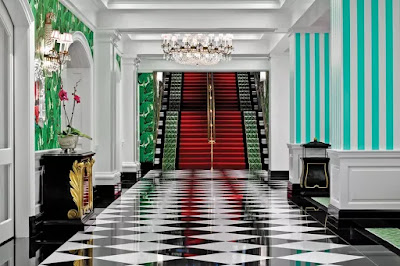WEEK 11 - Modernism in America (Part Two)
[Mid-Century Modernism]
We see the
second phase of modernism in the 1950's. In America, this was a period of
continued exploration and experimentation, especially in furniture design
because of the manufacturing process. This inspired new creative forms,
and allowed for the use of a variety of materials, including molded plywood and
plastics, metal composites, laminates, resin, and fiberglass.
Mid-century modern architecture was extremely popular on the West Coast. Joseph Eichler was a real estate developer who developed distinctive residential subdivisions of Mid-Century modern style tract housing in California. He and his Eichler Homes, Inc. build around 11,000 single-family homes in Northern California. This style is characterized by flat roofs, angular details, and asymmetric profiles; with great expanses of glass, and wide open floor plans. Also important was the connection between indoor and outdoor spaces. This was done not only with expansive walls of glass, but also with the use of warm, earthy color tones, to create nature-inspired interiors. Colors such as olive green, burnt umber, pumpkin, and mustard yellow. During this period, trendy colors, such as pink, gray, turquoise, black and yellow, were also experimented with. I like this about the Mid-century modern style because color adds so much character to a space, and also affect our experience of the space.
In the design of furniture, the thought of ergonomics (the study of people's
efficiency in their work environment) was important, especially in the
design of chairs. Furniture was made in a way that encouraged human movement.
Furniture was also designed for multipurpose; versatile and
interchangeable. During this period, there were two companies producing
furniture. One was Herman Miller, whose glory days were during 1945-1960; and
the other was Knoll, who was producing Eero Saarinen's furniture.
Historical Examples:
 |
| 1145 Barroilhet Avenue, built and lived in by Joseph Eichler. |
 |
| Tulip Chair, designed by Eero Saarinen in 1955 and 1956 For the Knoll company in New York. |
 |
| Marshmallow Sofa, designed by George Nelson (1956) Manufactured by Herman Miller |
Current Applications:
 |
| Skylight over kitchen; a concept inspired by Joseph Eichler As a way to marry interior and exterior. |
 |
| Nelson's Marshmallow Chair, still being produced today in different colors. |
One Step Further...
Eero Saarinen is a Finnish-American architect and industrial designer. He was born in 1910, and studied in Paris and at the Yale School of Architecture. In his works, he is known for using sweeping curves and lots of glass. He designs furniture with a sculptural approach, and uses materials such as fiberglass and aluminum. He is fund of using primary colors such as red, orange, yellow, and white.
Saarinen worked with Charles and Ray Eames, and produced furniture for the Knoll manufacturing company. He did not have one particular modern style, but designed according to the desires and needs of his clients. He believed that the purpose of architecture is to "shelter and enhance man's life on earth and to fulfill his belief in the nobility of his existence."
Some of his chair designs:
 |
| Womb Chair |
 |
| Grasshopper Chair |
 |
| Ring Chair |



Eunice,
ReplyDeleteThis summary really brings the ideas of new furniture to light. I was also fascinated by the achievements by Joseph Eichler and how he was able to connect the interior with the exterior. That idea is still sought after today with numerous skylights and a large amount of daylighting. The Marshmallow Sofa was also interesting to me as I used it as an example as well! It is very iconic and memorable!